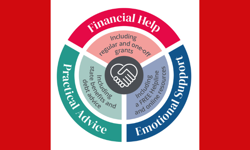The roundtable was moderated by media industry journalist and commentator, Ray Snoddy.
Tom Pepper, UK Managing Director of Vibrant Media said, “Rather than debating whether or not various ad units are native the industry should be focussing on higher level discussions such as responsible native advertising that will bring the media industry together in collaboration to achieve the best user experience. As Vibrant Media has been placing ads within digital content since 2001 we are well placed to step up to that challenge. We are really pleased that we have been able to facilitate this conversation with like-minded leaders in the industry. The 5 key principles we have agreed to achieve responsible revenue generating native advertising are: Integrity; Transparency; Proportionality; Relevancy; and Appropriate Placement.”
Tim Cain, Managing Director at the Association of Online Publishers said: "We are proud to have partnered with Vibrant Media who have brought together the key players in the publishing industry. Today is a great achievement surfacing the 5 key principles in responsible native advertising. Creating focused roundtables like these shows progressive thinking and thought leadership. We have definitely given the industry more focus today and I look forward to our continued success with Vibrant."
1) INTEGRITY – Editorial and advertising teams should collaborate
As editorial teams’ focus is on developing content that captivates consumers, they have key insight into the brand values that establish trust in their media titles’ content. Native advertising should be supported by editorial teams. Editorial, ad sales, marketing, creative and tech teams should collaborate on native ad campaigns.
Hattie Brett, Editor of The Debrief said, “My editorial integrity is very important to me. I see it as protecting the reader. Being involved in the native ad deals gives me a certain sense of control to make sure that we’re working with likeminded partners who share our brand values and understand that we know how to talk to our readers. Working on a native deal with someone who doesn’t share your title’s brand values is going to antagonise readers and drive them away, which is not in the publication’s interest or in the advertiser’s interest.”
Gary Rayneau, Head of Digital Sales at Dennis Publishing said, “Done correctly, done with integrity, native advertising is a really positive thing for the industry. If we get it right it benefits everyone: it benefits publishers by keeping them commercially viable; it benefits users as we can create interesting content.”
2) TRANSPARENCY – Be clear with consumers
Overt labelling and clear signals should communicate to consumers that native ads are marketing messages. Media literacy is important. Publishers and advertisers should provide consumers with accessible explanations about the native ads displayed within their publications.
The Guardian’s Head of Investment, Rob Smallwood said, “If you aren’t overt and you aren’t transparent you will get negative user feedback. Actually, our initial testing shows that labelling ads as ads improves response rates.”
ESI Media’s Jo Holdaway, Director of Strategic and Commercial Data said, “Publishers need to maintain trust with their readers, and if they don’t label something as advertising, whether it is native or not, that trust is put in jeopardy. Consumers still want to know that they are being sold to, whether the ad is perfectly in keeping with the publisher’s brand values or not.”
3) PROPORTIONALITY – Strike the right balance for the publication’s audience
When assessing the amount of native advertising to display within editorial, the balance should fall in favour of giving each media title’s consumers the content they want.
Head of Planning, Insight & Research at AOL, Steve Payne said, “The right proportion of native advertising to editorial content is dependent upon the publication and the audience – it depends on the readers, their age and the media title. But if publishers get the proportion wrong it can have a devastating impact on their relationship with their readers.”
Duncan Tickell, Commercial Director of Immediate Media said, “Clearly any site that completely bombards the user with commercial messages is doing it at an inappropriate level. It’s about maintaining the right balance, which publishers have done for many, many years.”
4) RELEVANCY – Ensure native ads are relevant to the consumer, the content and the media title
Native ads should be displayed in context – simultaneously relevant to the consumer, the content within which they are placed, and the media title’s brand. Native ads should both enhance and benefit from the consumer’s editorial experience.
Malcolm Attwells, Programmatic Sales Director & Acting Trading Director at, Condé Nast said, – “Native advertising needs to be relevant within the context of the content. The placement has to make sense. How it sits within the content is a key part of a native ad being relevant to what the user is looking at and doing at that time.”
Digital Brand Partnerships Director at IPC, Andrew Sanders said, “It’s about being conscious of your responsibility to the people that visit your site and why they are visiting your publication. We are there to entertain and interest them and not let them down.”
5) APPROPRIATE PLACEMENT – Be considerate in placing and distributing native ads
Native ads should unobtrusively fit the form and function of the media titles hosting them and function as intended on all devices. Brand safety and proper placement procedures should ensure native ads are suited to the editorial environment and their intended audience.
MEC’s Managing Director, Justin Taylor said, “We’re seeing a big change and scalability coming from the native ads distributed as small bite size formats that are integrated much more contextually within content. Native advertising is also about creating responsible and relevant advertising not just for that consumer, but for the device that they are on as well. On mobile phones consumers want something that is relevant to that phone, at that signal, at that time. On tablets they want something that’s more in depth. On the desktop they want to be able to follow links to more information.”
Tim Cain, Managing Director at the Association of Online Publishers said, “In terms of brand advertising strengthening the brand position, or repositioning the brand are two really key attributes that we know an editorial context delivers really effectively. We did studies ourselves last year where we looked at a number of content partnerships and found out just how effective presenting commercial content in that context was”
Participants in Vibrant Media’s Responsible Native Advertising roundtable were:
AOL, Head of Planning, Insight & Research, Steve Payne
Autotrader, Head of Display Advertising, Naomi Hahn
Association of Online Publishers, Managing Director, Tim Cain
The Debrief, Editor, Hattie Brett
Conde Nast, Programmatic Sales Director & Acting Digital Trading Director, Malcolm Attwells
Dennis, Head of Digital Sales, Gary Rayneau
ESI Media, Director of Strategic and Commercial Data, Jo Holdaway
Guardian, Head of Investment, Rob Smallwood
Hearst, Group Digital Sales Director, Steve Edwards
IDG, Publishing Director, Simon Jary
Immediate Media, Commercial Director, Duncan Tickell
IPC, Digital Brand Partnerships Director, Andrew Sanders
Maxus Global, UK Digital Strategy Director, Tom Dunn
MEC, Managing Director, Justin Taylor
Oldmedianewmedia.co.uk, Raymond Snoddy (Roundtable Moderator)
Royal Albert Hall, Digital Manager, Katia Hountonji
Reed Business Information, Sales Director, Chris Martin
Vibrant Media, Managing Director UK, Tom Pepper










